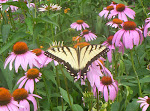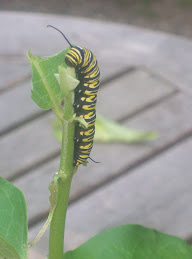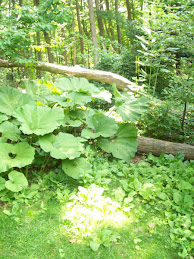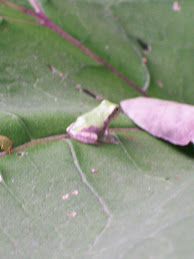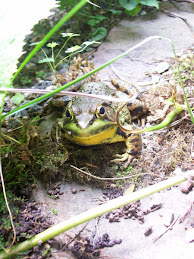Monday, September 7, 2009
Where have the Ladybugs gone?
When I lived in CA, I came across millions of them coming out of their winter sleep on a Spring day. There were so many it seemed as if the plants and tree trunks were painted in red along a creek. We were curious so we got out of the car and climbed down to the creek. We were amazed to see what had to be millions of ladybugs inches thick on everything. All was fine until the sun hit and they really began to move, taking to the air and crawling on everything including us. Evidently they are very hungry after a long winter sleep so they were well, nibbling. Like some wierd SCI FI movie we ran to our cars!
I also found another location outside of Volcano CA one late summer day. They were flying in to begin hibernation. They were also falling or as it seemed raining ladybugs.
So where have they gone, has some unscrupulous person or persons found their hibernation locations and killed millions thinking them as an infestation? Or have they succumbed to some unknown disease since they hibernate together, killing them like the bats in the northeast?
So rescueing a ladybug may have new meaninig these days, not only is it an old kids story and supposed to give good luck, but you may just be saving them for real.
Fall Migration
A Black Throated Green Warbler (new for me) was on the side of the driveway in the Japanese Maple. There were so many of them flying around I could not focus fast enough as they moved in and out of the tree tops. So I could not officially ID them though one did have a dark head like a Mourning Warbler, but I can't count it as I do not know for sure.
The warblers have always been a favorite of mine since moving here from CA. Each spring the oaks are full of them, sometimes up to 100 at a time and dozens of species, though over the last few years there have been less and less. This Spring was the worst ever but I hope that was because the weather was so bad for so long. In any case, they have been my favorite since Bob the cat (now deceased) delivered un harmed to me at the back door (and very proud of his catch) a Black Throated Blue Warbler in all of its Spring plumage. It of course did not appreciate the capture as it now expected to be the morning breakfast but was happy to be handed over to me. It perched on my finger for all of us to see, blinked a couple of times and joined his friends in the trees. Since then, I have looked forward to the visits of the warblers each Spring and Fall.
Though they do not stay all year, they are attracted or so it seems to a diverse amount of trees. Oaks of all kinds, Hickory, Dogwood, Ash, Maples of all types, Apple, Cherry, Plum, Pine, Fir and Sassafrass all are thick on our less than an acre lot. The understory of smaller trees such as Fringe, Spicebush, Witchhazel, Privet, Elderberry and others also attract them as its the insects they are after on their journeys to their nesting sights in Spring and their tropical winter vacation in the fall.
Water is also important, they all take baths in the waterfall and shallows of the pond. With songbrds seemingly on the decline, its important if you are a serious gardener to landscape some parts of your yard with the wild things in mind.....................remember, they were here first.
Wednesday, September 2, 2009
New Addition to Garden

After visiting PA a few weeks ago we stopped at a farmers market at a nursery and I found a huge and velvety looking Hydrangea. While I have seen photos of this plant, I have never seen one in person nor have I seen them for sale at any nurseries in NJ where we live.
Had to have this plant, huge velvet looking leaves were fantastic. I finally found a nursery with this plant still in stock on the internet and was able to get one of the few left...................... a stick with two leaves on it, I hope it grows fast because we want the plant in this picture.
Saturday, August 29, 2009
Dog Days of Summer
Gone are the myriads of flowers of Spring and June, however the steadfast bloomers of any garden are still producing. The coneflowers now in a variety of colors are still attracting butterflies some of them with the same tattered look as the leaves on the trees. Black eyed Susans, sunflowers or anything like them still bloom in what is a sea of yellow these days in the garden.
But if your smart you have planted the fall garden. Salvias, Asters, some Hydrangeas, etc will soon brighten the garden once more. Impatiens, Fuschias, and Begonias continue to brighten the shade, a treat for the Hummingbirds before they fly south in a few weeks.
Its also cricket and spider time here in NJ. The nights are loud, almost deafening. The few that get too low to the grass and the pond are a quick meal for the toads and frogs. And soon the great eastern migration will start, saw some warblers today in the elderberries with the Catbirds, who by the way have managed to eat pounds of berries leaving us pondering what to protect next year as they are just too greedy.
So your mind starts to wander........................and decide what garden projects you will do next year. What amazing, fantastic tasks you will decide to do and then never do. But part of the fun is the thinking and the possible evolution of the garden through new projects or the maturing of the plants and all around landscaping. Our grand plans would include a walk in butterfly cage, a nursery, a bog garden, an iris garden, native azalea garden, hardy orchid garden, and whatever else the imagination can come up with.
So soon we will have released the last of the Monarchs, and those who that will join them will begin to migrate south in a fantastic display along the coastlines that have dunes and goldenrod. Hundreds passing by stopping at Cape May before their long dangerous flight across the bay. Our last Black Swallowtail is hanging a few inches from my laptop. He will have to wait until morning. Then that will be it. All the butterflies will be gone until next year. So bring on the Fall.
With the amazing oranges and reds, cool autumn nights, campfires, smores, acorns, mushrooms, apples, halloween, and then the shimmer of first frost. So here is to summer, this year at least here in New Jersey it was not the best of summers, but who counts these things anyway Summer is Summer. Its full of life. Soon cozy comfy autumn will be here, and then the glistening clean crispness of winter. Then those projects I talked about earlier....................I wonder if its going to be a warm winter?
Tuesday, August 11, 2009
Lots of Butterflies in yard today
Tiger, Spicebush and Black Swallowtails all fought over flowers in the front yard, and others were flitting about in the woodland gardens. There were many skipper and hairsteaks, along with Hackberry?, Question Marks, Cabbage Whites and new for us, a Satyr of some type. Very shy and would not sit still for proper ID. The we released 8 Monarchs in the last 2 days, 6 today. With another six on the way. Also collected 40 eggs from the milkweed growing just in the lawn. And there are still more eggs.
Two more Black Swallowtails to go and all the Swallowtails have hatched into adults.
Even as I was able to work in the garden clearing paths from overgrown plants and weeds the butterflies seemed to check out the cleaned out areas. Planted some anemones, ferns, hydrangeas, native azaleas, and ligularia to finish a sloped area in the lower garden. It was instantly visited by two sparring Tiger Swallowtails. They love the yellow orange flowers of the Ligularias.
Well that is all for now, hope for more on Weds.
Saturday, August 8, 2009
Red Eyed Vireos
I was buzzed over and over by a hummingbird female. At first I thought she was mad because I was removing the impatiens but soon found out that there were 5 Red Eyed Vireos in the small shrub I suspect she has a nest in.
I have never seen any of these birds before so not only are they new to our yard, but new to my life list (that I have not been good at up keeping or adding to).
In any case, the Vireos hung around the pond for some time, in and out of the Elderberry, Spicebush and Hydrangeas around it. The female hummingbird actually came over to me as I sat on the lawn with my binoculars and hovered for a few minutes so close to my face I could feel the breeze from her nearly invisible wings. I guess she was thanking me, I don't know. But the Fuchsias on the patio attracted her attention and off she went.
The Vireos are gone now, flew over the rock wall and down towards the creek where I can see a pretty good size Buck taking a rest. He had better not snack on our garden after nap time is over. I have to get back to weeding and basically relaxing on this first day of vacation.
Thursday, August 6, 2009
Some plants you never heard of that will grow in New Jersey
So how about some things you never thought would survive those freezing cold winters. Nothing like north of Bergen County, but nonetheless, it gets pretty cold here on the New Jersey/New York border during the winter.
How about an Impatiens that comes back year after year, even in New Jersey. Not from seed, but like any other perennial. What about a Begonia. Not an annual, but one that looks tropical and comes back year after year and also survives the snow and ice. Or something strange from China that looks like a purple bottle brush!
Here are some of the stranger plants that you might not find at your local nursery, ok you won't find at your local nursery, but can be grown just like any plant you would find locally in New Jersey. These plants are very hardy.

 Impatiens Omeiana - The photo is not from our garden as my photographer (Chelsea, my daughter) is on vacation in Vancouver Washington. So I borrowed this from another website. But we have 6 clumps of this and they look about the same. They form a ground cover with yellow flowers in late summer/fall. Pretty deer resistant for some reason as well.
Impatiens Omeiana - The photo is not from our garden as my photographer (Chelsea, my daughter) is on vacation in Vancouver Washington. So I borrowed this from another website. But we have 6 clumps of this and they look about the same. They form a ground cover with yellow flowers in late summer/fall. Pretty deer resistant for some reason as well.Easily divided to increase your plants. Plants never form seed pods. Someone who has more knowledge of this plant will probably tell me it doesn't go to seed.
Remember no photographer, so this is a photo from one of our favorite nurseries website, LazySSFarms. But our plants look just like this. Ours probably even have a bit larger leaves.
 Begonia Grandis ssp evansiana - A bit late to come up in the spring which makes you worry each time that it may have succumbed to the cold.
Begonia Grandis ssp evansiana - A bit late to come up in the spring which makes you worry each time that it may have succumbed to the cold.Really easy plant to grow, multiplies well and can be divided easy as well to multiply your plants. Great woodland plant!
Japanese Shrub Mint. Leucosceptrum stellipilum. Pretty cool woodland plant. Deer have not touched this plant in over 8 years. Forms a nice low shrubby plant. In late fall, the blooms
appear, ours have many more flowers than this and are finer. Giving the impression of a bottle brush.

I have tried to grow this from cuttings but with no success. Not because they never rooted but chipmunks and squirrels have dug up each rooting I replanted as if I was hiding some nuts under the plant. Have no idea why, but the have done it time after time.
So I have patiently divided the original plant over the years. Now I have about 4 plants. The leaves look a bit velvety. I think this plant is related to Hydrangeas but I could be wrong. In any case, this is a really cool plant and deserves a chance in any ones garden.
While every garden looks good with some masses of plants, and we have that as well. It is the small nooks and crannies and the way plants grow together in size, leaf shape, leaf color, and flower that creates the perfect landscape. But our plants need to serve a purpose for wildlife. The begonia attracts the hummingbirds, as well as the Mint Bush that also serves a bit of nectar late in year for the Monarchs prior to their migration to Mexico. The Impatiens makes a great ground cover, growing along side ginger, it creates cover for toads, salamanders and Wood Frogs.
Will post another three really cool plants soon that should be in all nurseries and in your garden.
Monday, August 3, 2009
Goldfinches and Agastache

After these flowers have bloomed for awhile, the little goldfinches begin to arrive in late July, early August. The bees never stop. The big black and yellow bumble bees are there every day. We have planted a large row of these plants right under our family room window so we can watch at times a dozen or more goldfinches eat the seeds from the finished blossoms right at the window.
The plant is also called Hummingbird Mint and/or Licorice Mint. The purple flowered varieties are loved by bees and finches while the orange varieties are cherished by the Hummingbirds. All re-seed prolifically, so be prepared to have many, many seedlings after the first year. The purple varieties can survive in shade as well as full sun.
Also makes a fine tea and its leaves can be used as a mint substitute in drinks.
High Country Gardens Nursery has an excellent selection of these plants.
Sunday, August 2, 2009
Kayla


Forgot the other member of the family, she is our 13 year old Yellow Lab. Long in years now, but looked upon our garden as her own personal domain. Guarding it from rodents and deer but actually making friends with a female deer who now comes back each year to have twins in the safety of our little woods.................though I am sure she has eaten her take as well.
Kayla for years played in the garden with her faithful companion Bob, our manx cat. Bob has been gone for several years now leaving Kayla to watch over the yard for maybe one more year. She has been the best garden puppy ever!
Growing Salvias


After some searching, we have found some salvias that for years seemed impossible to find. We have always been interested in hardy varieties for Zone 6 beyond the normal and common types found at most nurseries. The photos are from other sites, wish ours looked like that! While those of us living on the East Coast do not have the Hummingbird species the west and southwest has, these salvias come back year after year for the little ruby throats that visit eastern gardens.
Recently we have been sent S Castanea, S Przewalskii (several varieties), S Flava v megalantha, S Bulleyana. Several seedlinigs of Castanea have sprouted and are taking off though this miserable NJ weather this year is not helping things.
While searching for these I found they are much looked for by Salvia enthusiasts, once we get them growing and have mother plants, we hope to offer some for sale or trade, but that is a year or two away unfortunately.

They are gone by this time of year, but for some 8 years now these three Mallards have arrived in our yard. They have grown to know us and sit under the kitchen window for food. Then they come to the back door.
They hang out at the frog pond most of the day and then fly away each day for the safety of a larger pond or lake at night.
Several times they have nested but have not been successful.
Pileated Woodpeckers
Hoping for Pipevines to visit
LazySS Farms Nursery has a great website. Plants come wrapped in perfect condition and our very large for the price.
Impatiens namchabarwensis "Blue Diamond Impatiens"

Something really cool from Annie's Annuals. Just arrived in mail last week, great size and has already grown much larger and is budded. Can't wait to have it flower and collect seed. We have an Impatien that is a perennial, yes that is true, even here in NJ. And we have several others that re-seed and put on quite a show all year.
Here is what Annie's Annuals says about this new plant for our garden.
Hold on to your hats, folks. This one’s a doosie! In 2003, an expedition to the (tongue-twisting) Namchabarwa canyon* in Tibet discovered this rarest jewel of a “jewelweed” – an ultramarine-blue flowered Impatiens. It was found in a very limited & remote location, but its scarcity doesn’t at all impede its cultivation - not only is this plant hardy (how hardy is as yet untested, so let us know) but it reseeds, making it a triple whammy of a plant – super rare, totally gorgeous, & completely garden worthy. The plants are compactly growing to about 2’, & very floriferous, & the flowers themselves are breathtaking in color & in form. The color seems to change with temperature & exposure – sometimes it’s REALLY TRULY BLUE, & other times it’s a deep purple, but it’s always exquisite. Truly a plant to treasure, if you can get your hands on one!
*A canyon that’s not only the deepest canyon in the world - twice as deep as the Grand Canyon - but is also an area that’s been studied only since 1994. Can you say WOW?
Note: Generally, species Impatiens prefer cool Summer climates with little frost, and suffer in areas with too much heat and humidity!
Pt.Sun/Shade | Regular water | |
Perennial zones 10a-11, reseeding annual in other zones | ||
Deer Problems
I am not sure about other areas of the country but deer are a huge issue in New Jersey. They are everywhere! While they are cute, they can be a huge problem to anyone with a garden. We actually have a deer that has had twins in our yard each year for several years now.
But if you want them to not treat your yard as their personal salad bar, that is a trick. We have tried just about every product on the market in 15 years. From the bizzare, Wolf and Coyote urine, it did nothing to stop them but I suspect if there were wolves in New Jersey it may have attracted them. Other sprays have pepper of some type, trouble is that means the deer would have to eat the plant to learn their lesson. I don't want them to touch a leaf!
Many of these leave a horrible glaze on the plants. There are several out there that use basically rotten eggs with a combination of pepper. But seem to leave a mess on the leaves as well.
After all these years, we have found a product that has kept not only the deer but those ground hogs away as well. Liquid Fence for Deer. Now we have to warn you. The first time you spray this lovely concoction on your plants, do not do it on a windy day. Also do not panic as the smell is unbearable and your thinking now you don't want to get near these plants either let alone stand in the yard. It lasts about 24 hours, dries without any residue and lasts 30 days with normal rain.
But remember during the 30 days, your daily visitors to the yard and testing and smelling, waiting for the odor to go away. Because at 30 days, if you do not spray.....................well its supper time once again. Liquid Fence has its own website. We ordered the sprayer with the liquid fence. The sprayer is pretty good quality and does not clog like those you might by at your local home improvement center.
I am pretty upset with the deer today since they ate my hostas and its raining, again. And they ate the tops off of every flower stalk, I think they were sending a message. But I sprayed anyway. Hope this helps other persuade their deer to go elsewhere for dinner and breakfast.
New to Blogging but here goes anyway.
Our yard is a registered National Wildlife Habitat and NABA (North American Butterfly Association) Habitat. We raise and release many butterfly species, our outdoor butterfly cage is currently under re-construction so my wife is putting up with many in house visitors.
We have no formal training in gardening, landscaping, etc. We hope that our daily adventures in our garden will inspire others to create gardens for wildlife no matter where they live.

